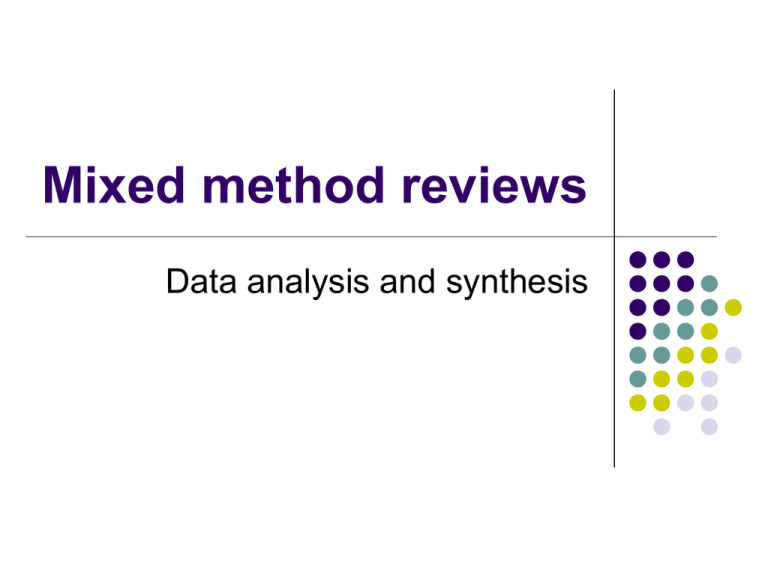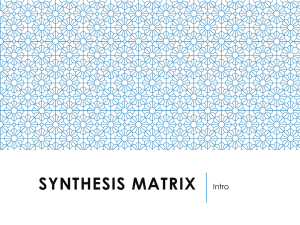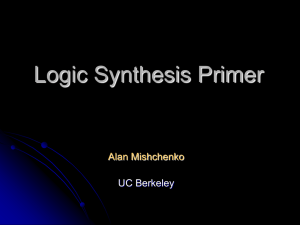Data Analysis and Synthesis March 2011
advertisement

Mixed method reviews Data analysis and synthesis Complexity “Some problems are so complex that you have to be highly intelligent just to be undecided about them” Lawrence J. Peter Narrative synthesis (NS) An approach to the synthesis of findings from multiple studies that relies primarily on the use of words and text to summarise and explain the findings of the synthesis Designed for integrating effectiveness and implementation data, but can be used to synthesise evidence for a wide range of questions including effectiveness, experience, need, process, implementation etc. Using a synthesis method Advantages Assists in review team communication and documentation Assists in making the processes of synthesis available to others for validation Assists with the presentation and communication of the results of synthesis Guidance Pope C, Mays N, Popay J (2007) Synthesising Quantitative and Qualitative Evidence: a guide to methods. Milton Keynes, Open University Press Popay J et al. (2006) Guidance on the Conduct of Narrative Synthesis in Systematic Reviews. Available at: http://www.lancs.ac.uk/shm/research/nssr/research/dis semination/publications/NS_Synthesis_Guidance_v 1.pdf What NS is, and isn’t A framework to increase the transparency and trustworthiness of the synthesis Includes description of tools and techniques Could be used to synthesise the findings from mixed evidence sources A guide to the whole process of systematic review – only the stage of synthesis A cookbook of tools and techniques to be selected at random Aims to be accessible, but not a guide for complete novices in research Relationship to systematic review Iterative not linear Question development Theoretical framework Search/data extraction Quality assessment Descriptive analysis Preliminary synthesis Interpretive analysis Final modelling/synthesis Theory testing /development Looking for patterns in data Generalise on basis of theory Phases of NS Phase 1: Develop a theoretical framework* Phase 2: Descriptive analysis + develop a preliminary synthesis Phase 3: Interpretive analysis: explore relationships in the data + construct synthesis Phase 4: Assess the robustness of the synthesis NB Not linear stages: phases are iterative *not always required Theoretical framework Purpose: to inform decisions about the review question, contribute to interpretation of findings, and to assess the applicability of the findings Sources: Research question Topic Theory Hypotheses Descriptive analysis Purpose: to organise findings to provide an initial description of patterns across the included studies Tasks: select, group, juxtapose Tools: Textual descriptions Groupings and clusters Tabulation Transform to a common rubric Vote count Thematic analysis Content analysis Descriptive analysis Descriptive analysis SELECT GROUP JUXTAPOSE Descriptive analysis Textual descriptions Groupings and clusters Tabulation Transform to a common rubric Counting Thematic analysis Content analysis Tools for describing: examples Textual descriptions: a short ‘story’ with key messages, significant information that acts as a ‘viewing platform’. Ordering/grouping: finding shared features and clustering studies along those lines Tabulation: Tables summarising key features of study objectives, design, context, findings Common rubric: Using a common framework to allocate material from multiple studies Counting: Using occurrence or vote counting to consider the frequency of phenomena in the data Content/thematic analysis: qualitative analysis EXERCISE: description Select summary information from the narrative description to put in a table, making sure that the table will fit data from all three studies Look at the types of clients, and context. Can you spot potential groupings? Look at the findings across the three studies. Can you spot potential categories or themes? Output: preliminary synthesis Descriptive narrative and tabular summary of the studies and findings Specification of analytical framework/common rubric Events, participants, contexts? Stages, phases, time? Ordering, grouping? Positives, negatives? Hierarchies, key issues? Preliminary synthesis Testing the theory with a subset of data to make sure it works Exploring relationships in the data Purpose: to consider relationships between: study results and key aspects of those studies (within) factors across included studies (between) Tasks: compare, combine, translate, integrate Tools: Identifying mediators and moderators Sub-set analysis Conceptual mapping Translation: reciprocal/refutational Qualitative case description Exploring relationships in the data RELATIONSHIPS ACROSS STUDIES COMPARE COMBINE TRANSLATE INTEGRATE RELATIONSHIPS WITHIN STUDIES Exploring relationships in the data RELATIONSHIPS ACROSS STUDIES Mediators and moderators Sub-set analysis Conceptual mapping Translation: reciprocal/ refutational Qualitative case descriptions RELATIONSHIPS WITHIN STUDIES Exploring relationships: tools Moderators and mediators: categorising and viewing the relationship between concepts according to their action on the phenomena of interest Sub-set analysis: Looking at actions, results or themes in groups, dependent on characteristics Visual representation: Concept mapping: links between concepts are labelled and placed in space to express a relationship Ideas webbing: concepts organised in trees, hierarchies Causal/cognitive mapping: representation aims to describe direction of influences, key issues in real life Translation: reciprocal/refutational: grouping and integrating study findings in terms of level of agreement/fit in argument/conclusions Qualitative case description: writing a short narrative summary across studies, concepts, themes, arguments Output: Synthesis Rigorous exploration of alternative interpretations of relationships between and across studies Some level of translation and integration with explanation of (e.g.) agreement/refutation commonalities/outliers order/groupings priorities/emphasis/frequency Identification of moderators (influencing factors), mediators (mechanisms of action) and sub-groups (components of programme theory) EXERCISE: interpretation Look at what you think might be the key concepts/themes drawn from the findings of the 3 studies Play with the concepts/themes spatially to explore the potential relationships and patterns across concepts Map the concepts/themes ACROSS STUDIES to denote some aspect of the relationship between them Assessing robustness Purpose: to assess the strength of evidence for drawing conclusions about the results of the synthesis in relation to methodological quality, relevance, trustworthiness Tasks: assess relationship of synthesis to original review question, programme theory, study quality and review method Tools: Assessing theoretical fit Validity assessment Weight of evidence Critical reflection Triangulation Checking with authors Assessing robustness REVIEW QUESTIONS PROGRAMME THEORY Assessing robustness REVIEW QUESTIONS STUDY QUALITY Best Evidence Synthesis Weight of evidence Validity assessment Critical reflection Checking with authors Triangulation PROGRAMME THEORY REVIEW METHOD Tools: assessing robustness Best evidence synthesis: prioritising/choosing studies with the strongest design Weight of evidence: using a criterion of strength or value to interpret the synthesis findings e.g. effect size, repeatability, harmony, coherence Use of validity/credibility assessment: using the results of critical appraisal to interpret synthesis Critical reflection: using the review author’s use of critical tools/techniques/methods to consider results e.g. agreement, alternative explanations, assessment of theoretical fit, parsimony, elegance Checking with authors: involving the authors of the primary studies in comment, reflection, or building theory/synthesis Triangulation: using the results of other data sources to compare the results of the synthesis Exercise How do you think the methods and quality of the original studies would affect the interpretation of the findings? Output: robustness Identification of any limitations in the process of review and synthesis Assessment of the credibility and trustworthiness of the synthesis product, seen through the provenance, quality, and strength of the evidence Assessment of the significance of the theoretical contribution Identification of its potential use and further development Review product suggestions Formal report: PRISMA guidelines method analysis: description, interpretation conclusion: theoretical contribution implications Practitioner report: content, examples, visual illustration best practice guidance tools, resource lists Common problems Volume of material Level of material Heterogeneity of material Disaggregation Crossing disciplinary boundaries Lack of guidance on synthesis method Time Skill in original research methodology






